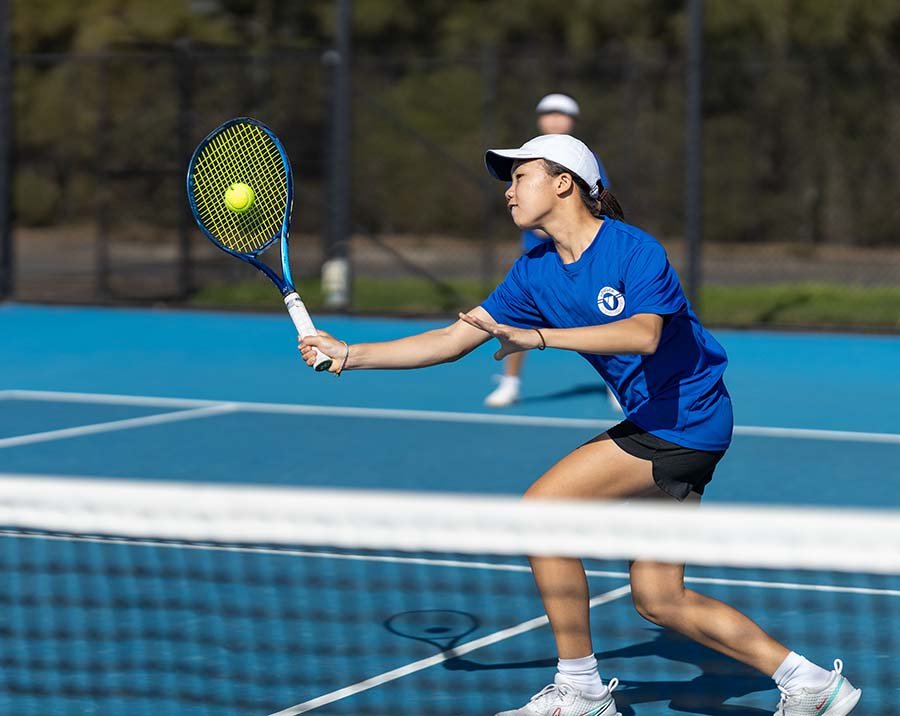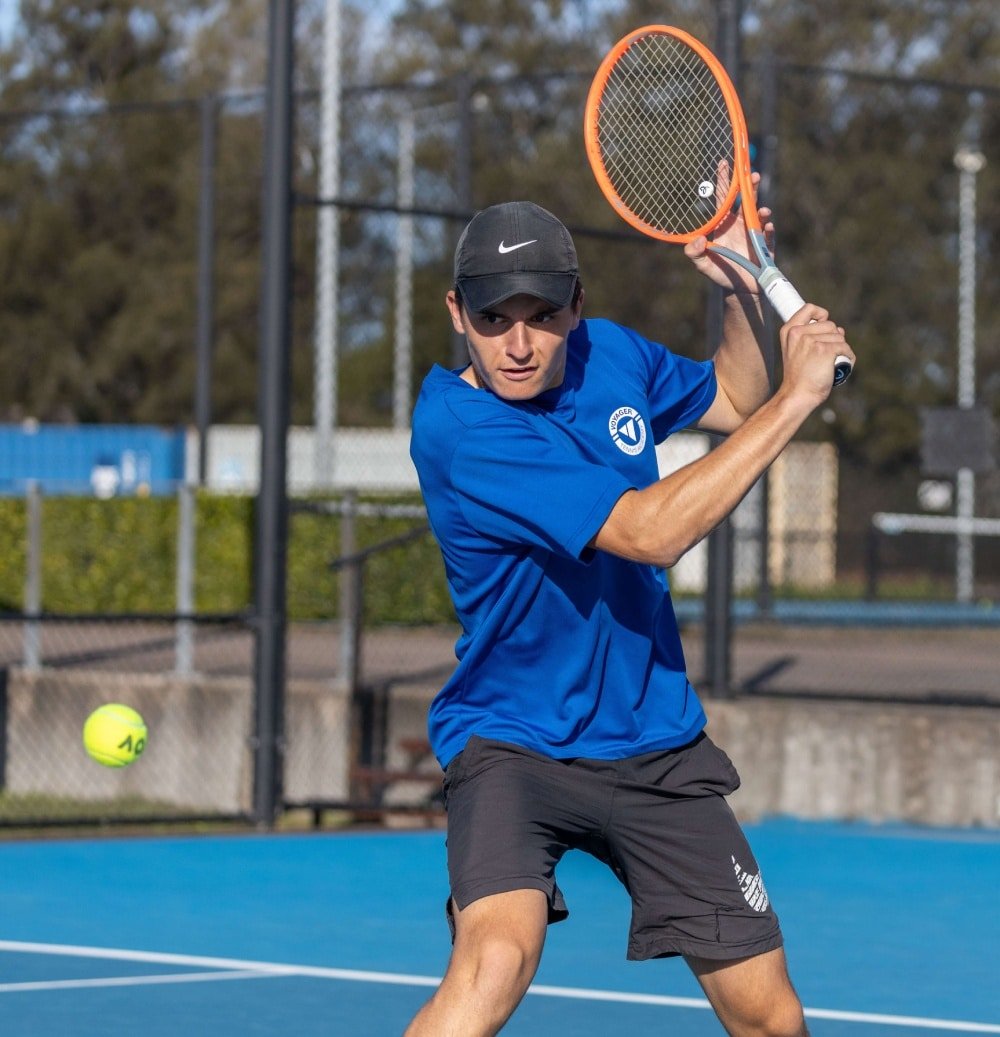
Playing a high volume of competitive matches is one of the most beneficial things a player can do to develop their game, their ranking and their UTR.
Our case studies and database show that match-play quantity is the strongest determinant of the level that a player reaches. Without exception, the best players in any country have a high match count.
This article outlines the benefits of match play to a tennis player and includes target match-play quantities which are dependent on the level your child is aspiring towards.
The benefits of match play
Match play is a key means for a player to develop their game, and playing matches against opponents of a similar level is the best way to accelerate their development. The more competitive matches a player can play, the better match player they become. The reasons for this are:
- Tactically, players become more intelligent and pick up on common patterns that opponents use, reading the play earlier and earlier over time.
- Physically, players’ bodies become accustomed to the intensity, rhythm and duration of competitive matches. Over time, they build up a strong tolerance to deal with all of the physical demands of tennis.
- Mentally, players become accustomed to handling the ups and downs of matches and high-pressure situations. Players who don’t compete tend to panic and play the big points poorly, while experienced match players stay more composed and execute more effectively under pressure.
- Intensive practice of a key shot in tennis – the serve and return. Statistically 70% of all points are won/lost in the first four shots, which makes the serve and return one of the most important shots, but often training sessions don’t devote a lot of time to the serve and return. The players with a high match count become skilled in the first four shots of each point, but the vast majority of tennis players and parents don’t realise this.

Match-play scheduling
There are a number of critical factors when it comes to producing a successful schedule for your child:
- Planning the appropriate number of matches for your child’s goals. Knowing how many matches they need to play each year will influence how many tournaments and match-play opportunities you’ll need to be pursuing.
- Win/loss ratio. Perhaps the most important factor in developing your child’s tournament schedule is adjusting it constantly to ensure they have a win/loss ratio above 50%. Ideally, strive to put together a tournament schedule for your child that provides them with an average of two wins to one loss if possible. As a general rule, if a player has been on a winning streak, it is time for them to play up and compete in more challenging tournaments. On the flip side, if a player has taken a series of losses in a row, look at match-play options where the competition is not as strong. There is generally nothing worse for a player’s confidence than to take a number of consecutive losses, so from a parent’s perspective, you need to keep an eye out for this and take action as soon as you see it happening.
- Complementing tournament play with competitive matches from a number of different sources.
- Seeking tournaments in conditions that suit your child’s game style.
Doubles are crucial in developing match-play skills
A lot of parents and players overlook the importance of doubles and just play singles at tournaments. Doubles has a lot of benefits, such as:
- Improving adjustment skills considerably due to the quick exchanges and reflexes required.
- Giving a great opportunity to get experienced at the net. A lot of junior players have a strong baseline game, but don’t come to the net often. Doubles is a great way to counteract this.
- It is all about serve and return and first shot, which relates well to singles.
- Giving players more experience in playing under pressure. In doubles, particularly at a high level, there are many tie breakers and tight matches.
- Experiencing tennis as a team sport. This can be a lot of fun as your child shares the highs and lows with a teammate.
- It can be a great confidence booster as your child can often beat players in doubles that they may not have beaten in singles, which can help them win more singles matches.
We strongly suggest that players always enter doubles at tournaments. Make sure your child finds a partner that they combine well with and enjoy spending time with.
Target match-play quantities
Below are the average match-play counts of all the case studies we conducted. The most important column is match-play quantity to date. This is how a player can determine if they are on track with the level they are targeting or need to catch up.
Level 1 | ||
National position | These players are typically among the best few players in their country for their age group. | |
US college opportunities | Tennis scholarships into most prestigious US college teams + Ivy League opportunities. | |
Playing opportunities |
- National ranking tournaments (usually winning or making finals for their age group) - Junior World Championships (Orange Bowl/Tarbes) -ITF Junior World Circuit (if prepared to sacrifice education and travel extensively)
- Area representation (country representation)
- European club tennis (potential to be paid well for every match) - Professional ATP/WTA tour (top 100 in the world possible) - Seniors tour (likely highly world ranked for age groups) | |
Level 2 | ||
National position | These players are typically good nationally ranked players who are around the fringe of gaining acceptance into closed national title junior events in their respective countries. | |
US college opportunities | Tennis scholarships into good Division 1 colleges. | |
Playing opportunities |
- Local inter-club tennis (competing against other teams in area) - Inter-school tennis competitions -National ranking tournaments
Area representation (local or state representation)
- European club tennis (payment likely to represent a team) - Professional ATP/WTA tour (lower and mid-level professional possible) - Seniors’ tour | |
Level 3 | |||
National position | These players are typically among the best few players in their country for their age group. | ||
US college opportunities | Tennis scholarships into Division 2, junior colleges and below | ||
Playing opportunities | Some common and suitable opportunities for these players are:
- Local inter-club tennis (competing against other teams in area)
- Area representation (local or regional)
- Seniors’ tour (will compete well in local senior tour events) | ||
Benchmarking male players | ||||||||
Levels | Level 1 | Level 2 | Level 3 | |||||
Age/Year at school | P/week | To date | P/week | To date | P/week | To date | |||||
Age 7/Year 1 | 60 | 60 | 0 | 0 | 0 | 0 | ||
Age 8/Year 2 | 65 | 125 | 45 | 45 | 0 | 0 | ||
Age 9/Year 3 | 65 | 190 | 50 | 90 | 35 | 35 | ||
Age 10/Year 4 | 85 | 275 | 60 | 155 | 40 | 75 | ||
Age 11/Year 5 | 95 | 370 | 70 | 225 | 45 | 120 | ||
Age 12/Year 6 | 110 | 480 | 75 | 300 | 50 | 170 | ||
Age 13/Year 7 | 110 | 590 | 75 | 380 | 55 | 225 | ||
Age 14/Year 8 | 110 | 700 | 85 | 465 | 60 | 285 | ||
Age 15/Year 9 | 120 | 820 | 90 | 555 | 60 | 345 | ||
Age 16/Year 10 | 120 | 940 | 95 | 650 | 65 | 410 | ||
Age 17/Year 11 | 120 | 1,060 | 100 | 750 | 65 | 475 | ||
Age 18/Year 12 | 120 | 1,180 | 100 | 850 | 65 | 540 | ||
Benchmarking female players | ||||||||
Levels | Level 1 | Level 2 | Level 3 | |||||
Age/Year at school | P/week | To date | P/week | To date | P/week | To date | |||||
Age 7/Year 1 | 60 | 60 | 0 | 0 | 0 | 0 | ||
Age 8/Year 2 | 65 | 125 | 30 | 30 | 0 | 0 | ||
Age 9/Year 3 | 65 | 190 | 35 | 65 | 30 | 30 | ||
Age 10/Year 4 | 80 | 270 | 45 | 110 | 35 | 65 | ||
Age 11/Year 5 | 90 | 360 | 50 | 1,386 | 6 | 840 | ||
Age 12/Year 6 | 100 | 460 | 55 | 215 | 40 | 145 | ||
Age 13/Year 7 | 100 | 560 | 60 | 275 | 45 | 190 | ||
Age 14/Year 8 | 100 | 660 | 65 | 340 | 45 | 235 | ||
Age 15/Year 9 | 110 | 770 | 65 | 405 | 50 | 285 | ||
Age 16/Year 10 | 120 | 890 | 70 | 475 | 55 | 340 | ||
Age 17/Year 11 | 120 | 1,010 | 75 | 550 | 55 | 395 | ||
Age 18/Year 12 | 120 | 1,130 | 80 | 630 | 60 | 455 | ||
The above tables are a guide only and the data are based on the average number of matches that other players have played to reach their particular level.
Once you are clear on your child’s tennis goals, you can determine how many matches they need to play each year and create an appropriate yearly tournament/match-play schedule.
The next article will also discuss some of the key considerations to make when preparing for competitive match play.
By Ryan Henry, Managing Director of Voyager Tennis and Ex-Pro Tennis Player




